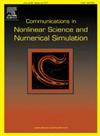基于色散转移网络的时间序列识别与分类新框架
IF 3.8
2区 数学
Q1 MATHEMATICS, APPLIED
Communications in Nonlinear Science and Numerical Simulation
Pub Date : 2025-09-22
DOI:10.1016/j.cnsns.2025.109353
引用次数: 0
摘要
利用复杂网络进行时间序列的非线性分析越来越受到人们的关注,其中有序网络以其简单和计算效率得到了广泛的研究。然而,现有的有序网络方法表现出两个局限性:1)在时间序列离散化中对等值的处理不足;2)忽略了一些幅度信息。它们可能危及复杂系统的表征。为了解决这些局限性,本文提出了一种分散转移网络框架,该框架包括节点智能熵和基于动态转移信息和Wasserstein距离的Wasserstein熵曲线,以识别系统的性质。Wasserstein距离的引入提高了从概率分布中提取信息的稳定性和全面性。节点熵和熵曲线分别是局部度量和全局度量。数值结果表明,该框架具有较强的识别不同动态信号的能力,能够显示系统特性随参数的变化。在实证应用中,所提出的方法可以应用于金融数据分类,无需复杂的预处理。我们还将这些方法应用于铁路波纹检测,并与其他九维降维方法进行了比较。该方法获得了最满意的分类结果。熵曲线还可以与多维尺度相结合,用于生理时间序列分类。本文章由计算机程序翻译,如有差异,请以英文原文为准。
A novel framework for time series recognition and classification based on dispersion transition networks
The use of complex network for nonlinear analysis of time series has attracted increasing attention, among which, ordinal networks have been widely studied for their simplicity and computational efficiency. However, existing ordinal network methodologies exhibit two limitations: 1) inadequate handling of equal values in time series discretization, 2) neglect of some amplitude information. They potentially compromising the characterization of complex systems. To address these limitations, this paper proposes a dispersion transition network framework, which includes node-wise entropy and Wasserstein entropy curve based on the dynamic transition information and Wasserstein distance, to identify the properties of systems. The introduction of Wasserstein distance improves the stability and comprehensiveness of the information extracted from the probability distribution. The node-wise entropy and entropy curve are local metric and global metric, respectively. Numerical results show that the framework have a strong ability to distinguish signals with different dynamics and can show the variation of system properties with parameters. In the empirical application, the proposed methods can be applied to financial data classification without complex preprocessing. We also apply these methods to railway corrugation detection and compare them with other nine dimensionality reduction methods. The most satisfactory classification results are obtained by the proposed methods. The entropy curve can also be combined with multidimensional scaling for physiological time series classification.
求助全文
通过发布文献求助,成功后即可免费获取论文全文。
去求助
来源期刊

Communications in Nonlinear Science and Numerical Simulation
MATHEMATICS, APPLIED-MATHEMATICS, INTERDISCIPLINARY APPLICATIONS
CiteScore
6.80
自引率
7.70%
发文量
378
审稿时长
78 days
期刊介绍:
The journal publishes original research findings on experimental observation, mathematical modeling, theoretical analysis and numerical simulation, for more accurate description, better prediction or novel application, of nonlinear phenomena in science and engineering. It offers a venue for researchers to make rapid exchange of ideas and techniques in nonlinear science and complexity.
The submission of manuscripts with cross-disciplinary approaches in nonlinear science and complexity is particularly encouraged.
Topics of interest:
Nonlinear differential or delay equations, Lie group analysis and asymptotic methods, Discontinuous systems, Fractals, Fractional calculus and dynamics, Nonlinear effects in quantum mechanics, Nonlinear stochastic processes, Experimental nonlinear science, Time-series and signal analysis, Computational methods and simulations in nonlinear science and engineering, Control of dynamical systems, Synchronization, Lyapunov analysis, High-dimensional chaos and turbulence, Chaos in Hamiltonian systems, Integrable systems and solitons, Collective behavior in many-body systems, Biological physics and networks, Nonlinear mechanical systems, Complex systems and complexity.
No length limitation for contributions is set, but only concisely written manuscripts are published. Brief papers are published on the basis of Rapid Communications. Discussions of previously published papers are welcome.
 求助内容:
求助内容: 应助结果提醒方式:
应助结果提醒方式:


